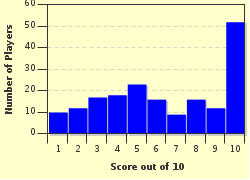Quiz Answer Key and Fun Facts
1. Saint Boniface was born in Devon around 672AD. His feast day is June 5 and he wrote the first Latin grammar produced in England. He was murdered while trying to convert the Frisians in 754. Of what is he the patron saint?
2. This saint was born around 639AD and was the first Abbot of Malmesbury. He is credited with installing the first church organ in England and is a patron saint of musicians amongst others. Can you name this man whose feast day is May 25?
3. This man was the 25th Archbishop of Canterbury, but during the reign of Eadwig he had to spend time as an exile in Flanders. His fortunes were restored under the rule of Eadgar and he is patron saint of lighthouse keepers among others. Who is he?
4. Saint Alban was the first English saint and martyr. He was a pagan who converted to Christianity and was beheaded during the persecutions of Septimus Severus around 209AD. What unusual thing happened to his executioner when he chopped Alban's head off?
5. Next we have a girl who was an assistant to Saint Boniface in his travels around Europe. She was canonized in 870 by Pope Adrian II. Her feast day is celebrated by bonfires on April 30th and she is patron saint of rabies amongst other causes. Who is she?
6. Saint Osmond was actually a French nobleman and came to England with his Uncle William in 1066. After a remarkably chaste but successful life he was canonized in 1457. What, amongst other things, is Saint Osmond a patron of?
7. Although better known for other things, this man is the patron saint of engineers. He was born around 387AD in Roman Britain and kidnapped into slavery when he was sixteen. Who is he?
8. Saint George has been Patron Saint of England since 1348, but who was his predecessor in that role?
9. This man was a Benedictine monk at the monastery of St Peter in modern day Sunderland. He wrote "Historia ecclesiastica gentis Anglorum" and is known as the Father of English History. He is also the only English Doctor of the Roman Catholic Church. Who is he?
10. The Forty Martyrs of England and Wales are a group of Catholic martyrs who died without recanting their faith between 1535 and 1679. They were canonized on 25th October 1970 by which Pope?
Source: Author
mikew41
This quiz was reviewed by FunTrivia editor
CellarDoor before going online.
Any errors found in FunTrivia content are routinely corrected through our feedback system.


